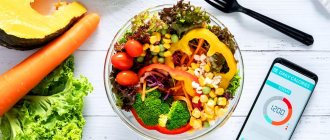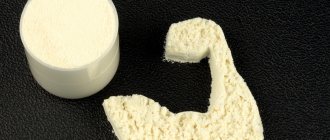What is energy value
The energy value of food (calorie content) is the energy that a person is able to absorb from them, that is, release in the process of biological oxidation of proteins , fats and carbohydrates .
However, nutrients are never completely absorbed by the human body. Carbohydrates are absorbed by 98%, fats by 95%, and proteins by 92%.
The nutritional energy value of food is measured in units such as calories or joules per 100 g of product.
To calculate the calorie content of food products, they are burned in a calorimeter and the amount of heat released is measured. One calorie is spent on heating 1 gram of water by 1 °C. For convenience, everyone uses kilocalories (kcal). One kilocalorie is spent on heating not 1 g, but 1 kg of water.
Why do you need to calculate nutritional and energy value?
The calculation of energy (EC) and nutritional value (NV) refers to the procedure for establishing the exact content of carbohydrates, fats, proteins, as well as vitamins and mineral compounds in a product or product. In its process, the content of each of the given indicators is determined for product packaging (100 g or 100 ml).
Why is the calorie content of foods calculated?
Calculation of the calorie content and nutritional value of dishes and products is mandatory for all food product manufacturers without exception, including catering establishments.
The norms of current legislation (in particular, the Federal Law “On the Protection of Consumer Rights”) provide for the need to provide consumers with complete information about the products sold. The information is printed on the label or directly on the packaging. Having studied them, a potential buyer can make a choice in favor of one product or another.
Labeling rules are contained in TR CU 022/2011. This tech. The regulations establish that food products must indicate their calorie content, as well as the content of biofuel. Information about the composition of the dish and its nutritional value should also be provided to visitors to cafes, restaurants, canteens and other catering establishments.
Note! The manufacturer does not have the right to label goods and provide information about them to consumers without a properly completed BZHU protocol. Markings are applied on its base. This document is drawn up based on the results of studies conducted in laboratory conditions.
Providing false information about the composition of a product and its calorie content is a violation of the law, which is punishable by fines.
Methods for determining indicators
To accurately determine PC and EC, it is necessary to know the energy coefficients of substances established by current standards, the method of preparing a dish (product) and other information.
You should also distinguish between the concepts of nutritional and energy value. In the first case, we are talking about the presence of certain nutritional components in the product and its balance. Data on the components of the product are compared with established indicators.
In the second case, the amount of energy that a person receives with the food consumed is determined.
The calculation is carried out using one of two methods:
- laboratory - involves testing in an accredited laboratory - during testing they use the Kjeldahl method, spectrophotometric research and liquid chromatography;
- calculated - in this case, all the components that are included in the recipe of a dish or product are taken into account, after which the values for each of the components are determined.
The following data is used as a basis:
- 1 g of fat contains 9 kcal;
- 1 g of protein – 4 kcal;
- 1 g of carbohydrates – 3.75 kcal.
If an entrepreneur needs to calculate the content of BJU, the calorie content of dishes and other food products, for this you can turn to specialists from a certification organization for help. Experts will help you choose the least expensive calculation method and conduct the necessary research in a specialized testing institution. If necessary, they will provide assistance in obtaining permits for food products and developing labels.
More details about calculating BZHU and determining calorie content can be found by following the link 1okno.com/articles/raschet-pishevoj-i-energeticheskoj-cennosti.
Information about the presence of certain nutritional components in a product is indicated provided that their mass fraction exceeds 2% of 100 g or 100 ml. As for mineral compounds (micro- and macroelements), for them this figure should be more than 5%.
What is needed to calculate nutritional and energy values?
If an enterprise needs to calculate these indicators in accordance with legal requirements, for this purpose it will be necessary to provide:
- application for services;
- a copy of the charter and registration documents of the entrepreneur;
- a list of products, products or dishes for which it is necessary to determine the content of nutritional components and energy value;
- those. documentation on the basis of which products are manufactured - this includes technical equipment. conditions, GOSTs, as well as enterprise standards;
- description of each product - includes its full name, distinctive features, ingredient structure;
- detailed data on production technology.
Algorithm for obtaining a calculation
Since determination of the caloric content of a product and its composition is possible only with a properly drawn up test report, the manufacturer must send product samples to an accredited laboratory. The calculation procedure is carried out according to the following algorithm:
- the entrepreneur submits an application to the certification portal specialists;
- During a free consultation, it is necessary to clarify the details of cooperation - terms, cost;
- then the applicant provides the information necessary to carry out the procedure;
- if the data is calculated in the laboratory, then you will need to provide product samples (to perform a set of studies);
- then testing is carried out in laboratory conditions, and the necessary calculations are made;
- The customer is given a BZHU protocol and calculation.
Energy balance of the body
The body's energy balance is a state in which the amount of energy entering the body is approximately equal to its expenditure, which allows one to maintain a stable weight.
There are types:
- Negative energy balance is a state where energy expenditure exceeds energy intake. It is observed during fasting and following all kinds of diets. The body begins to use all incoming nutrients, as well as fat and muscle, as energy.
- Positive energy balance is a state when the amount of energy entering the body exceeds its expenditure. This is the main reason for excess weight.
An example of calorie calculation and menu adjustments
Using a calorie counter, you can calculate the nutritional value of both a small snack and a full breakfast, lunch or dinner within one or two minutes. Suppose you plan to eat for breakfast:
- fried potatoes – 150 g;
- stewed beef – 50 g;
- canned cucumber – 50 g;
- bread (sliced loaf) – 25 g;
- coffee with sugar – 250 g.
To determine the calorie content of breakfast, you need to enter information about each menu item into the application, indicating the name and weight of the portion. After the program processes the data, the user will be shown the calorie content of each dish, as well as the energy value of breakfast as a whole and the amount of proteins, fats and carbohydrates consumed. The user will be able to see the following results on the screen:
- fried potatoes – 288 Kcal;
- beef stew – 116 Kcal;
- canned cucumber – 8 Kcal;
- bread (sliced loaf) – 66 Kcal;
- coffee with sugar – 145 Kcal.
In total, breakfast contains 623 Kcal, the total weight of consumed products is 525 g, including:
- proteins – 17.63 g;
- fats – 26.63 g;
- carbohydrates 76.48 g.
If you need to lose excess weight, it is recommended to review the menu and choose an alternative to high-calorie foods. For example, fried potatoes can be replaced with a similar-sized portion of boiled potatoes, reducing breakfast calories by 165 kcal.
The calorie counter makes it easy to create a daily menu, which is important for people who are struggling with excess weight and must follow a diet that involves consuming a limited amount of calories and carbohydrates. On the website you can quickly determine the list of dishes and the volume of portions that you can eat during the day, without going beyond the established limits.
How to calculate your daily calorie intake
The energy value of the diet is calculated individually. Energy expenditure varies from person to person. They depend on age, height, body weight, and physical activity. But despite this, it is possible to identify different groups of people with similar energy expenditures.
As an example, I will calculate the recommended calorie content:
- for women height 165 cm and weight 57 kg;
- for men height 178 cm and weight 70 kg.
Calculations will be for people of different ages and physical activity.
Light activity refers to the light loads of everyday life.
Average activity will be for people with three workouts per week.
| Age | Kcal |
| Women are inactive | |
| 20+ | 1800 |
| 30+ | 1700 |
| 40+ | 1700 |
| 50+ | 1600 |
| Women with average activity | |
| 20+ | 2000 |
| 30+ | 1900 |
| 40+ | 1800 |
| 50+ | 1700 |
| Men are inactive | |
| 20+ | 2400 |
| 30+ | 2300 |
| 40+ | 2200 |
| 50+ | 2000 |
| Men with average activity | |
| 20+ | 2600 |
| 30+ | 2500 |
| 40+ | 2400 |
| 50+ | 2200 |
Note! For those who do not coincide with the calculation group, they will have different recommended caloric intake standards. If you are taller or heavier, your energy needs will be slightly higher.
Which food groups are the most and which are the least nutritious?
Products differ in energy value.
The calorie content of complex dishes or whole food depends on their composition, the choice of raw materials with lower or higher energy value, as well as on the technological processes or culinary processing methods used.
The most calorie-dense foods come from foods rich in fat, such as oil, and carbohydrates, such as refined sugar. The food group with the lowest calorie content is vegetables, and fruits, due to their higher sugar content, also have a higher energy value.
For example, one medium cucumber provides about 15 kcal, and one medium pear provides about 60 kcal. Fresh and frozen vegetables and fruits are generally low in calories. But dishes prepared from these products have a higher calorie content, since its growth is affected, for example, by the addition of sugar, butter or mayonnaise.
Alcoholic drinks also provide a significant amount of energy. They contain no fat and the sugar content, except in sweet wines and liqueurs, is negligible, although 1 g of pure ethanol provides up to 7 kcal.
Information about the energy content of a food product can be found on its packaging, usually in the nutritional value table. In contrast, the energy value of a meal or daily diet is calculated by adding up the energy value of the individual foods that make up your meal.
Is calorie counting accurate?
So, having understood what a calorie is, we can answer: it is the approximate amount of energy required to raise the temperature of one gram of water by one degree Celsius.
The key word is “approximate” amount of energy.
People consider nutritional value because it is simple, convenient and helps control food intake. But it is impossible to calculate with an accuracy of one or even a hundred how much energy your body spent and consumed.
Even apps and devices that calculate kcal consumption during physical activity provide inaccurate information.
Counting calories is not an accurate method, even if you weigh portions down to the gram. But measuring accurately is not necessary. You just need to try to follow the corridor as accurately as possible, understanding that there will still be errors in the numbers.
But it's still a useful tool - a rough guide to your tendency to overeat.
Food calorie tables
As a rule, tables show the average energy value of products. In most cases, the energy value is indicated per 100 g of raw product.
When calculating, take into account the change in calorie content during heat treatment of products - calorie content will increase by 10% - 50% depending on the type of processing.
These tables are intended solely to give you an idea of what calories are and to help you plan your diet. Knowing the calorie content of foods does not replace consultation with a specialist and treatment of diseases.
Fruits
| Product | Calorie content per 100 g |
| Apricot | 48 |
| Avocado | 160 |
| A pineapple | 50 |
| Orange | 47 |
| Watermelon | 30 |
| Banana | 89 |
| Grape | 69 |
| Grapefruit | 42 |
| Pear | 57 |
| Melon | 36 |
| Blackberry | 43 |
| Kiwi | 58 |
| Strawberry | 32 |
| Cranberry | 46 |
| Coconut | 354 |
| Lemon | 29 |
| Raspberries | 52 |
| Mango | 60 |
| Nectarine | 39 |
| Papaya | 43 |
| Peach | 42 |
| Tomato | 18 |
| Rhubarb | 21 |
| Plum | 46 |
| Dates | 277 |
| Blueberry | 57 |
| Apple | 52 |
Vegetables, grains and legumes
| Product | Calorie content per 100 g |
| Artichoke | 53 |
| Eggplant | 25 |
| Broccoli | 34 |
| Brussels sprouts | 43 |
| Green peas | 81 |
| Mushrooms | 22 |
| Green bean | 31 |
| Green pepper | 20 |
| White cabbage | 35 |
| Red cabbage | 31 |
| Corn | 86 |
| Lettuce | 14 |
| Bulb onions | 40 |
| Chard | 19 |
| Carrot | 41 |
| cucumbers | 15 |
| Olives, black | 116 |
| Rice, white, boiled | 96 |
| Celery | 14 |
| Asparagus | 20 |
| Beans, canned | 135 |
| Cauliflower | 25 |
| Zucchini | 21 |
| Garlic | 149 |
| Canned lentils | 165 |
| Spinach | 27 |
Meat, poultry and dairy products
| Product | Calorie content per 100 g |
| Lamb, cooked | 265 |
| Ground beef, cooked | 260 |
| Roast goose | 304 |
| Fried chicken | 223 |
| Turkey, light meat, roasted | 169 |
| Yogurt, plain, low fat | 63 |
| Rabbit, cooked | 172 |
| Chicken breast, cooked | 175 |
| Butter | 717 |
| Milk, semi-skimmed | 50 |
| Milk, whole | 60 |
| Fried venison | 190 |
| Pork belly, cooked | 518 |
| Beef steak, fried | 235 |
| Cheddar cheese | 408 |
| Veal, fried | 229 |
| Duck, cooked | 336 |
What you need to provide when contacting the CA
To calculate the nutritional value of a product you need to provide:
- copies of OGRN and TIN;
- information about the product for which calculations need to be made;
- product samples, provided that the indicators will be determined in a laboratory;
- ND, on the basis of which the production of goods is organized;
- other information about the product.
Entrepreneurs can seek help from a certification center to calculate the shelf life of products, their environmental friendliness, and the absence of genetically modified organisms. If necessary, assistance is provided in obtaining permits.
Submit your applications!










